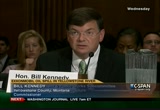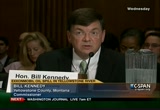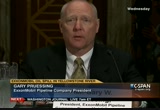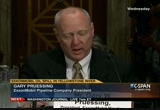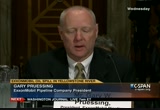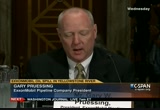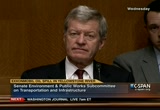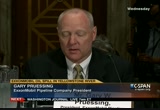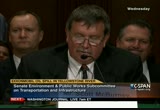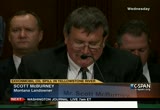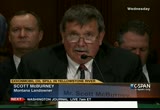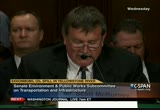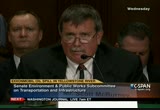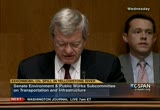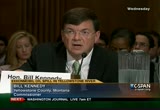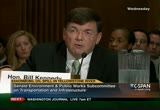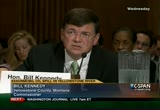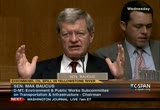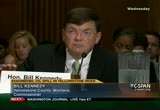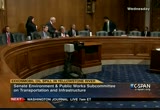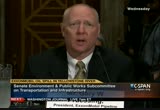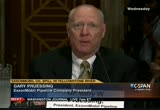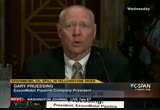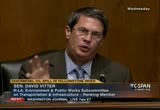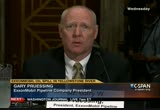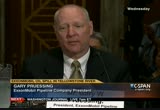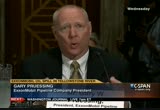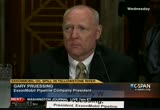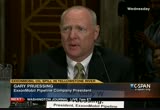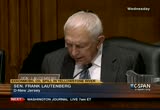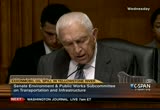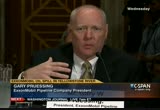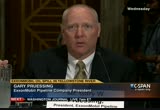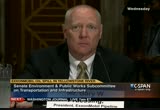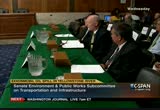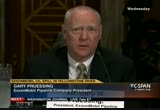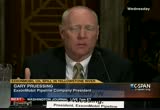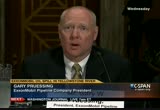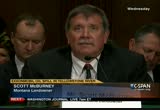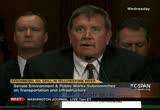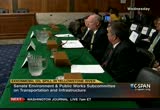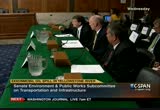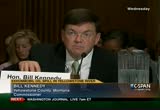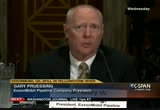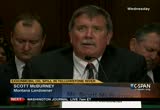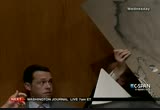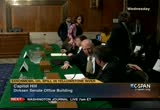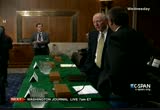tv Today in Washington CSPAN July 21, 2011 6:00am-7:00am EDT
6:00 am
agencies, but they have never worked with the local elected officials. the city of laurel was brought up because we saw a problem. the ongoing dialogue with yellowstone county, i don't think it was even mentioned in the dialogue today so they can say local officials are still not openly included. i would say all parties seem to be working for this, for the clean-up this going to be, i hasn't had that date at all. and the one thing that we have not known in the county is what are the rules and what standards are we going after. we've also involved our extension agent who works with all thing a cultural land owners. and we asked him to get involved.
6:01 am
i was with your louisiana county commissioners. i was with the florida county commissioners. and county commissioners along the gulf states. as they were talking about oil clean-up. the one thing that the national association of county's and also county commissioners on the gulf state and everyone that has had oil spills have talked about is we need policies under the pollution act. we believe the federal agencies that do oversee o.p.a. must be required to consult and coordinate with local governments in environmental protection, oil spill planning, training and implementation of the processes. that's needed, that's one thing we have seen from this spill.
6:02 am
we have been working with our local agency and our local landowners. but it seems we're the last one to get the call and to sit down and talk about it. and when everyone leaves town, and it's all over, we're still the local elected officials are there. thank you. >> thank you. >> i appreciate the opportunity to speak with you about the pipeline incident that happened in yellow stone and to update you on the progress to clean up the spill. before i begin, allow me to repeat our sincere apologies to the people of montana. we deeply regret this incident occurred and we are steadfastly committed to not only complete the clean-up, but also to build the learnings from this incident
6:03 am
into our future operations. we do not yet know the precise cause and will not likely know until our investigation is complete. we do know the pipelines had met all regulatory requirements, including a 2009 pipeline inspection, a december 2010 depth survey, and additionally as recently as last month the u.s. department of transportations pipeline and hazard materials administration performed a field audit. and of course we do know the effects of the incident. we began closing valves and
6:04 am
minimize release. we estimate no more than 1,000 barrels spilled. drawing upon local resources from the exxon mobile billings refinery as well as our experts from across the country. a unified command center led by the environmental protection agency and involving more than 750 people now direct the response. this coordinated effort is crucial to effective clean-up and recovery. this includes professionals from
6:05 am
femsa, montana fish wildlife parks, the yellowstone county commissioners, local response organizations, international bird rescue and many others. as part of our clean-up strategy we have divided it into four zones. in the first two clean-up zones covering the combined distance of approximately 19 miles we have deployed approximately 52,000 feet, and several vacuum trucks, boats and other equipment to capture oil. our priority is to insure clean-up is safe and effective. the task made more challenging by the persistent high water levels in yellowstone river. on july 17 we completed a two day procedure to remove any remaining crude oil from the silver tip pipeline at the crossing.
6:06 am
it was directed at the direction of the overnight of the e.p.a. through the unified commend we continued to conduct air and water quality monitoring over 200 miles of the river as well as wildlife assessments and recovery efforts. today e.p.a. monitoring confirms there is no danger to public health and no reported water system impacts. we've also brought in recognized experts such as international bird rescue to actively monitor the impact on local wildlife. so far impacts have been limited in smaller numbers and the list is available on the website. monitoring and mitigating impact will remain a priority of ours throughout the clean-up. as the chairman knows, the silver tip pipeline plays an important role in surviving energy to the area and therefore helps sustain local jobs and economic growth. we are committed to replace the damage pipe using horizonal
6:07 am
directional drilling techniques, with a new section that we will lay approximately 30 feet below the river bed. a fair amount of concern to us is the impact of the local communities. we established a community information line and we received more than 370 calls. about 160 of those calls or claims related to property, agriculture and health and we are actively responding to each of those. we have also sent several teams door to door to visit more than 250 residents in the most impacted areas. it is our goal to respond to individual concerns within 24 hours. i'm pleased to report that these efforts have mostly received a very positive response. in fact about 160 calls to the information line have been offers of help. this outpouring of local support is immensely helpful.
6:08 am
testifies to the generosity of the people of montana and we deeply appreciate their understanding and support. to repeat, exxon pipeline company takes full responsibility for the clean-up. but we also equally committed to learn from this incident and to build these learnings into future operations. thank you. >> thank you. next? >> senators, thank you for the honor of allowing me to testify. i'd like to give a special thanks to senator bob's staff. since 2005 i have lived near the yellowstone river with my wife sue and two sons. we own four horses which we keep on 20 acres. we have no river frontage but are very close to the river. we put up most high quality grass a which we sell.
6:09 am
it had not been cut this year because it was too muddy after the big may flood. july 1 was a pretty hectic day. the river was in full flood mode for the third time this year and geological survey forecast the river to be at 14 feet. at that level, the water covers most of my hay pass sure and inches from getting into any shop and barn and less than a vertical foot from being inside my house. there were some pretty nervous people at my house that way. my wife and family had gone to bed and i was getting ready to do the same when the laurel volunteer fire department showed up. the owedor was really strong when i walked out the door and i got to tip my cap to them, driving around in the dark looking for houses next to a flooding river. it was a mandatory evacuation and we found a motel in billings
6:10 am
at about 1:30 in the morning. we got home the next day i walked out and found we had a problem. oil had come over the ditch next to the river about halfway down my pasture. it was lying in the short grass where i had cut some hay. when you get away from the property, oily water stood in the ditches and in the pasture. the tall, uncut hay had acted like a big brush and stopped a thick line of oil. there was something else that was troubling to me. the water standing in the pass sure that during the two previous floods was an ugly brown color. i made a call to exxon mobile. we were called later in the day by crawford company who were acting as company's insurance. we had several meetings with the people from crawford and exxon mobile and they've always been very helpful and more than fair. crawford wrote us a check for
6:11 am
the hay we hasn't cut. and for the loss of our pasture. the thinking is that once the ground dries out, exxon mobile will remove all the grass in the affected area. on july 15, proper brought up a check for our hotel expenses. also agreed to pay us to buy an electric fence and a water tank so we could put our horses out on the undamaged portion of our pasture with a temporary fence. we put up the fence and the horses are out there getting fat. we have been talking to crawford about independent soil testing. they have given tentative approval for this. they would like an estimate from the company doing the work. and we're not trying to find someone to do it. we attended a meeting july 15 at laurel high school. the information on air quality was good news. the air was fine, it smelled bad for a couple of days but that's all. the question i had about soil testing is not quite as clear. the e.p.a. was going to do more with a comprehensive plan not put forward at that point. the information or advice on
6:12 am
agricultural matters was incorrect or non-existent. the e.p.a. came to my house and took soil and water samples. it ended up seeming more like a public relations move than a request about information for my property. they brought television crews, my wife sue was the lead story on channel 8 news that night. so it was exciting, but i couldn't help feeling a little disappointed. i felt like the water testing was a bit overdue. that's almost a month after the pipeline broke. on the whole, i think e.p.a. is doing a good job. probably too early in the process to think about the concerns i have, long-term effects on soil and water. they're cleaning up oil and that's what they should be doing. the montana department of environmental quality came out to do some soil samples on monday. they took three samples. i need more information. how much oil is too much oil on
6:13 am
my property? what's the long term effect of oil on my grass, what if it comes back? why is some of my grass dying and some of it growing? there seems to be a gap in the knowledge that e.p.a. guys don't know much about farming and the farm guy doesn't know much about oil spills. i think the biggest story is property values. the reason i want independent soil testing is i want to have a report in my file cabinet that i can show anybody might be considering buying my place some day a clean bill of health, if you will for my property. i feel like exxon mobile owes me this. the same with my water well. i'd like the well to be tested for maybe three years or something. i don't think my water's bad. i just worry that somebody else might. we will face a lot of problems from our hay customers as well and i'd like to have some science behind the answers for them. thank you. >> thank you very much. i'll start with mr. kennedy,
6:14 am
what are some of the questions that you would like to have been asked or answers given by the e.p.a. folks? you said as county commissioner you were not consulted very much. what are some of the areas that you would like to have answers to? >> senator, when the unifying command center was started, it was the e.p.a., it was the responsible party and it was d.e.q. with the state of montana. the local government wasn't included until i made a point of going back and saying we need to be sitting at the table. then i was asked the question, you'll just go along with whatever everyone else does. and i said i would like to see what's being talked about. so we can answer the quicks for
6:15 am
our own local yokes to be answered -- >> what are some of the things you could have helped them with? >> i think the one thing we did help them with to begin with is we wanted to make sure there was a face to every land owner that was affected. and we provided the g.i.s. survey, the map, the names and the addresses to all the local land owners. we were able to mitigate between a lot of the land owners and actually offered to go out and meet with any of the land owners and also exxon or e.p.a., a lot of the local folks trust us and we would help them through the process. the other is the public meeting process. to begin with we called the press conference to make sure
6:16 am
the public understood. we didn't get for days any sampling so we could get out to the public so we could tell people what was actually in the sampling. i know there's an ability to sample and come back right away with at least to verify that there was no public safety problem there. and then come back with the final results and all of the everything that's in there. we needed to assure the public. the other piece that we did is we brought to the table the city health department which is our health person in the county that had to assure the public between the drinking water, between the health effects, there was no problems there. they trust the local people.
6:17 am
the other thing we hear senator, with the local elected officials we're there years after the problem occurs. and we can followthrough with making sure that the plan is adhered to. but we do need to be a part of the plan to know that we can at least monitor the plans in the future after everybody leaves. >> do you have standards you've recommended to e.p.a. and to exxon that you want to see met that will be adhered to 5, 10, 15 years from now? and what is the value of his property five, 10, 15 years from now? he wants something to file so show that it's cleaned up 100% if some potential purchaser
6:18 am
comes along. are there things like that -- >> senator, we're going to need to be able to answer those questions. and to have a standard and the scientific research, looking at the sampling, we need to come back and be able to assure that those standards were met. >> i suggest that you figure out what those standards should be if they're locked in place. now, when five, 10 years, 15 years -- >> we would like those standards put into plan. we'll be working with our extension agent and our folks in the county. we do have some folks that are experts in these fields that we can bring that information back. >> other two panelists, anybody say something so outrageous that
6:19 am
you need a response? the panel that proceeded you, did either of the two witnesses say anything that you would like to respond to? >> i would like to talk about d.o.t. and the monitoring. the city of laurel did come forward and they were worried about the high water. everyone has been worriedability -- everyone has been worried about high water senator. we've had record snow pack in the mountains. we were lucky we didn't get 90 degree temperatures like we have before. the water went up. we had major flooding in different areas. we had scouringer under bridges. so the city of laurel was right to call and say they had some real concerns. they're concerns were -- and they were very legitimate.
6:20 am
i think they were looked at and moved on because it was high water and you couldn't get anybody on the river. but i really do think that when the local government be it the municipality, be it the county, we do need to get indepth and look at what could happen in the future. i think the one thing that we're looking at now is we haven't had flooding like this since 1978, actually or last flooding on the yellowstone river was down in the huntly area back in 1998. so i think we all became a little at ease with the river we've gone through the drought years. i think we need to beef it up and everyone needs to respond to high waters. >> great. thank you very much. >> thank you mr. chairman, thank you for this hearing. this is very important because the event is very significant
6:21 am
and also as a person from louisiana, i take great interest in this because we obviously have many, many pipelines, so the same potential vulnerablity. i have several question for mr. prusing. there's been a lot of discussion in the media on conflicting timing about how long it took to shutdown the oil flow in the pipeline. can you describe that process in some detail. and in particular why couldn't you simply close the blocked valves on either side of the yellowstone river first? >> thank you very much for your question senator. first, let me run through what occurred on the evening of july 1. this particular pipeline is operated out of our operations control center in houston, texas. that is where we operate all of our pipelines across the united
6:22 am
states. that is the typical technology for pipeline companies to have trained experts and all of the equipment running just single control center where you can operate the pipelines, the pumps, the valves from that one spot. at 10:40 p.m. mountain time on july 1, we saw a pressure drop on the pipeline in our control centers. the operators at that time did not know what was tallly occurring. they did not know a pump had shutdown, whether an instrument has failed or something else. they analyzed the situation for several minutes. when they could not determine what was going on, they made the decision to shutdown the pumps. so those pumps were shutdown at 10:47. so within seven minutes we had the pump shutdown. we then proceeded to close individual valves along the pipeline to isolate various segments of the line. many of these obviously are remotely controlled valves with the operator in the control center to turn a button, press a button and close some of those
6:23 am
valves. shutting down the pipeline is not like turning off your fause set in your home. you can't just close the valve and have everything shut off. you have a lot of mass moving at high velocity. when that occurs, if you were to close the valve all the sudden you could over pressure your line. that is an issue. so we have a number of various valves along the pipeline. and it's a rather detailed and complex procedure to make sure you don't create additional problems. we actually isolated the valve right at the river bank at 11:36. it took us 49 minutes to close that valve from the time the pumps were shutdown to the time that valve was closed. we actually still at that point did not know specifically at what sight we may have an issue. it was not until 11:45 p.m., or approximately nine minutes later we received a call from the fire department from the city of
6:24 am
laurel to our control room saying there was a smell of patroleum. that was really the first indication we had of where the issue was. we had proceeded to contact the n.r.c. at 12:19. when we tallly pinpointed the issue as was mentioned, they had come and visited our control center and gone through the log of the various steps that were taken. when the valves were closed. but that's the actual details of what the actual process detailed. >> thank you. we're obviously seeing reports of plenty of wildlife impact. but apart from direct wildlife impact, there clearly must have been impacts to soil and plants on the banks of the river that will impact wildlife including fifth.
6:25 am
what are you doing to address that? >> we are working closely with the unified command, of course led by the e.p.a. working with the state and responsible parties. each day we go out and survey the river. using area flights as well as walking the river. that data is then brought back on a daily basis and the plan is amended to identify where you're going to send resources out the next day to do the clean-up work. as was mentioned earlier, we have over 500 people now out on the banks of the river doing the clean-up. that oil was spilled, probably one of three things happened to it. a portion of it evaporated, as was mentioned earlier. a portion of it was broken apart and will bio degrade in the river naturally. and a portion got pushed out to
6:26 am
the edge of river where we're having to do the clean-up. we are working with the unified command on a daily basis to identify what areas to go out and respond to and make sure that we have the resources in the right places. >> ok. before the break, for weeks and even months, there's obviously high water and flooding potential. given that before the break, what did you do to think about and ensure pipeline safety? >> we have a detailed, and that's just another one that's in program. certainly the first step as was mentioned earlier today is that we are required to do a risk assessment on all of our pipelines to make sure we understand what potential risks are there. this particular line had an inline inspection in 2009. and again as was mentioned earlier, that did not uncover any issues from an integrity
6:27 am
standpoint -- >> i don't want to cut you off but i'm really talking about specific to the high water and the flooding threat fairly near before the rupp sure. what did that provoke or not provoke? >> we had taken a step in december 2010 to do the depth recover survey. we confirmed that with the depth recover survey. that was about 12 feet. we did determine under the river bank. in addition we actually shutdown the pipeline for a day to step back and do a further risk assessment to look at all the data that they had to identify if there were any issues that could cause us additional concern. this is a process that we would normally do when we have river
6:28 am
flooding. i'll just give you an example. obviously from the state of louisiana, we had to respond to issues of the mississippi flooding this year. when they were talking about the spillway for the first time since 1973, we identified several pipelines we had across the river. the last time that was open, we had some issues with our pipeline in 1973. so we did a risk assessment. we decided that was too great a risk based on history and the details of the lines. we shut those down and filled them with water before it was opened. we were fortunate those pipes were not damaged. even when the addition of water was flowing in, and we later worked to put them back in service. but we used that same kind of process here on the yellowstone crossing. we looked at the risk and all the details of pipeline integrity.
6:29 am
we looked at the depth of coverage. from a broad perspective did we feel like we had any risk from the high waters? at that time we concluded that we had a safe pipeline so we put it back in service. obviously something happened here that we did not yet understand. something very unusual. we were very anxious to complete our investigation as well so we can learn from that. >> thank you for your courtesy. is exxon conducting any independent testing, is anyone else conducting completely separate separate testing? >> right after the incident occurred, we started doing hygiene testing of the air. that was within place of just several hours of the time we knew we had to deal with. did demot show any particular issues from a standpoint but we
6:30 am
did put that in place right away. once the unified command was in place we tried to work our activities through the unified command so we have full alignment with the e.p.a. and the montana d.e.q. >> thank you mr. chairman. i ask consent that my opening statement be entered into record. mr. pursing, i want to ask you how many times has femsa come to exxon and asked about problems with the silver tip pipeline? >> femsa does regular audits. they actually did a very detailed assessment of this
6:31 am
particular silver tip line in june of this year. >> had you been notified of any problems that they saw? let's talk about period from 2003 on. >> the last time we did an actual inline inspection was in 2009. after that inspection was completed, femsa looked at those records and they identified four, five things that they wanted us to respond to. they were not particularly integrity issues on the pipeline but they were items that they identified that we needed to improve. that included removing some vegetation near a portion of the pipeline, adding some paint on a portion that was above ground. doing some additional walking patrols on the pipeline and not just ariel patrols. actually correcting them on top of the valve bonnets. those are things that all
6:32 am
responded to and at the time this incident occurred we did not have any outstanding issues from a regulatory standpoint on this pipeline. >> i have a list of criticism and complaints that femsa talked to exxon mobile about, going back to january 30, 2003. proposed compliance order, notice of amendment, february 18, 2005, probable violation, compliance order, proposed civil penalty. and the list goes on. there are nine of those, and that doesn't sound like it's very insignificant or relatively minor things to me. do you think -- i'm sure you're aware of these. >> senator -- >> would you say they're minor? >> senator, any time that an item is identified by the
6:33 am
regulatory agency we need to respond to it quickly. again, the normal process that the regulatory agency uses to notify the operator of issues that they need to respond to are the type of items we talked about. notice of probable violation, those type of documents that are sent to us is the mechanism by which they perform us to go respond. >> let's look as recently as june 82010. warning letter sent based on the 2009 standard inspection of the issues to raise the break out mixture was leaking and the tank was operated by exxon mobile's refinery. and june 8, also 2010 based on 2009, inadequate procedures for break out tank maintenance and operator directed its
6:34 am
procedures. but it seems to me that there's a frequent si of issues that question whether exxon mobile here is doing what they have to protect the safety and well-being. has exxon mobile responded to these and gotten approval from femsa that says ok, these things were taken care of? >> yes senator, actually by the time we received that warning letter, all of those items had already been taken care of. >> so just a coincidence that these things happened and here
6:35 am
was this break out, this damage that it did? sit doesn't sound very efficient to me that there seemed to be a series of things that needed attention. and why they had to be called to the attention of a company like exxon mobile to avoid problems here it looks like these things were leading up to the problem and ultimately resulted in this terrible accident. >> but we certainly take our responsibilities very seriously. >> well, it doesn't suggest -- mr. chairman i would like to put this list on the record. >> thank you senator. i've got a couple of questions.
6:36 am
mr. prusing, as you mentioned a pressure drop, i'm just curious how this works. is there a control room? >> yes, there is a control room about the size of this room, a number of computer screens where they bring in information from our pipelines across the country. some of that information comes in on telephone lines, some of it is sent through satellites. but they're able to monitor all our pipelines. >> in this case, i'm just curious, is there somebody watching the gage go down? or is there a computer programmer, a certain drop in pressure? bell goes on? light flashes, i'm just curious. >> all of those are accurate. we have a number that would give
6:37 am
an operator if something unusual was happening. >> do you know what happened to this case? >> in this particular case, they immediately called in their supervisor to look at the screen and understand what was happening. and when they couldn't figure out exactly what had occurred, they decided to take a step to shutdown the pumps. >> how many sectors are there on this line between houston and laurel? >> i don't know if specific number of centers. i would certainly be glad to get back to you on that. i'll have to get back to you on the specifics of this line. >> if you would. i'm curious, some timeline i saw a blocked valve was shut and then reopened for maybe 10, 15 minutes something like that. what was that all about? >> that was accurate.
6:38 am
-- actually again when we did not know what was occurring but we looked at what had happened or where the pressure drop occurred, the operators determined since the line sloped down into one of our delivery points at one of the local refineries that reopening that valve would drain oil away from that segment and have it delivered in. that was done from a safety perspective to say let's get them away where we may have an issue. so it was reopened consciously to get the oil drained by gravity into the delivery point. it was later closed to make sure we fully isolated the line. >> where is that valve? >> that particular valve is north of yellowstone river, down stream of where the event occurred. >> in order to get oil flowing downhill? >> yes. there's always twi a check valved to -- there's actually a
6:39 am
check valve. so reopening that valve would allow the oil to twain into the delivery point. >> it was laurel folk that notified you first, rather than the company itself with its senses and gages and computer programs figuring it out. >> that is certainly something the industry continues to work on trying to develop new technology and how to monor various lines and make sure we have the right sensors to pinpoint when there was an issue. >> and the exxon mobile is committed to fully winning up? >> absolutely. >> how much does the company budget for the clean-up? >> right now we're not worried about budgets, but resources for
6:40 am
getting the clean spilled up. >> so irperspective of the cost? >> absolutely. >> a lot of people are asking him about his property values down the road. a lot of clean-up here, commend e.p.a., exxon mobile for all that work. but to be honest about it, they're a little concerned about what will be the value of their land, what will be waste, will be oil, will be residue. montana wants to know that it will be in good shape. so i'm going to ask you, nest year, year after, feevepb five years from now, when land owners show their property damaged, you convince me to make them whole. >> first of all let me first apologize to you personally for the troubles we've caused and we
6:41 am
are committed to stand behind the complete clean-up. as far as longer term sampling, we want to work with e.p.a. and other officials to make sure that we have an agreed plan and what that is. and we have not set a specific plan on what that sampling will be. we will work on all the applicable agencies to make sure . >> you didn't really answer my question. my question was would you commit to me today to make them whole? several years from now they can show that their land has been damaged? >> we certainly will stand behind all legit claims. >> including drops in land values? >> i will certainly ask our people who handle those kind of claims to get involved in that. but certainly we now have over 40 people on the ground up there trying to respond to all of the concerns of the people in the community.
6:42 am
we don't have any farm lo for anything. we want to work with the individual land owners and make sure we address all of the land issues. >> sounds like you're pulling your punches a little bit. on one hand exxon said they will make everybody whole. but on the other hand if there's still damage five, six years from now that can be demonstrated because of the oil spill you're not saying you're going to compensate? >> no, again, we'll stand behind honoring all legit claims. >> so for example, five, six years from now has something that shows there's still damage on his land because of the oil spill, he tries to sell it and the sales prices is 30% lower than what it would be, you'll makeup that 30%? >> that is why it's really important to work with the applicable agencies to make sure we do the necessary soil testing
6:43 am
now to determine if there was any issue with regard to the land. so we certainly want to work closely with all the agencies to make sure the proper testing is done now. >> i understand. but if it's shown that there can still be damaged, do you commit to making it whole? >> yes, if there's a legitimate claim, then we certainly will honor that. >> all right, i appreciate that, thank you. just a couple questions about trenching versus drilling. i understand just to be safe that exxon's going to replace the current line with the drill line. is that correct? >> that's correct. that has been the recommendation with femsa and we certainly agree with that. we had actually independently come to that conclusion that that would be the necessary technology to replace it.
6:44 am
today using direct drill technology is more common place. >> what about the rest of the rivers in montana? some are trenched. >> we're doing risk assessments consistent with the order we received from femsa. part of that process started this week. we actually brought in a boat with side sonar technology. we've done an initial sounding in the billings crossing which is not where the instrument occurred but where it crosses back, across the river to get to the common mobile refinery. it did not indicate any exposed pipe but we'll be working with femsa and e.p.a. and montana d.e.q. to do that in greater depths so we actually know where the lines are located in that
6:45 am
crossing. so that is something we need to do and certainly agreed to to make sure the river crossings are safe. >> i appreciate that. now, i heard you say you're a little concerned about testing, like the e.p.a. folks came out and had a limited sampling, if i heard you correctly. although i hear they do a pretty decent job, but just you know sometimes the devil in the details. if you could just expand upon some of the clean-up that you've experienced. and how widespread it is. should it be better in your perspective? >> well, first let me say it's an evolving process. and as far as i try to mention, most of our concerns are down
6:46 am
the road a year from now when this is over, two years, three years, next year am i going to have hay? what's it going to look like. as far as my place in particular, tomorrow i have a meeting between, a meeting with a soil expert in billings is going to come out to my house. and representative of exxon is going to be there and they're going to talk and try to see if crawford insurance company will pay to have this guy do some testing. so i can have that. a site specific analysis of my property is what i feel like i need. the oil impacted my pasture progressively, the more river water came in, the more oil i had. so i felt like i needed multiple tests on my soil. and the other thing is i had ponding of water with oil in it.
6:47 am
and is different. it's a different impact i'm afraid than just the oil rushing over the surface of the ground. and then flushing on down the river. i had a pond of water on my property. the oil came in and stayed. and water evaporated. i'm a little concerned about that. i do think e.p.a. is on the job. i heard a rumor that they were going to do more, more thorough soil analysis on selected parcels. i'm not in the loop so to speak on that. >> to feel very assured, what would you like to know and who would you like to give that information to you? is it e.p.a.? the county? exxon? >> i would like somebody to
6:48 am
know. like i said in my testimony, we went to a meeting a week ago today and there wasn't really anybody there that crossed that agricultural versus scientific oil boundary. it was kind of a gap there. and i'm hoping i can hire that guy and that's his expertise and i can have at least for myself i can have those issues resolved. i'm not convinced that my property is damaged. i really don't know. i don't know how much oil's on my property. it's an unknown. so it's a source of worry for me. >> right. let me ask mr. prusing, what's the best way to help him out? he's concerned about oil as it mixes with agriculture. so far, how can we help him out? >> this is a very good example
6:49 am
of what i spoke about earlier about wanting to work with each individual land owner individually because their concerns may be different or issues may be different. if we need to get additional expertise out there that meets the bridge between science and agriculture, we'll find that kind of resource to help address positions. >> and mr. kennedy, any thoughts on that one? >> senator, this is a perfect example of every individual land owner that has been affected. when we say make them whole, this plan should incorporate a piece so it's individualized for each one of them we address their issues, be it 10 acres, be it 20 acres, be it 100 acres along the river. i think we can do that. the number one area that you're talking about is between our extension agent and some other experts. we should be able to get a standard and know what may happen over the next five, six years and see what those
6:50 am
samplings are. our biggest problem is the samplings have taken so long to get the results back. with that, we're not so sure the samplings have been taken -- >> why does it take so long? >> you know, i can't answer that question. e.p.a. has said they've taken the sampling and have not gotten the results back. that was our biggest frustration for the first four or five days is how come it's taking so long if this is an emergency situation. can't we get at least some results back right away for the public. i think that's where scott is. knowing that after he has certain areas of his property that he wants sampled and knowing what's there, and then
6:51 am
possibly monitoring it in one year and two years from now to check and see. and what those levels are. and i guess with the county, we like to know what those levels are, and see what the standards are so we can actually go back and say these are the standards that have been set out. >> we all want to help each other out here. what can i do to help to any of you three? to help land owners especially? we're here to serve the land owners. what can i do to help move this along? >> senator, i would say number one is the cooperation of the agencies working together. and by you insisting on the agencies working together and expedite some of these results so we can get the plan going and working with the land owners. number two would be to the
6:52 am
pipeline is going to have to go through. being able to get that pipeline drilled so it's safe and to get oil back in the refinery is another issue that we have in our community. there's 280 employees there. number three is what we need to do is all of us make sure that our land owners, the people that live in our county that have been affected are satisfied with the results that are coming forward. and i think as we go forward on that, just your involvement with this brings a lot of credibility as we work at these federal agencies. >> any help from e.p.a.? >> e.p.a. and femsa have been very professional in working
6:53 am
with us, providing direction and helping us work through these problems. >> well, i would like to echo his excitement. a lot of my friends work at exxon mobile and i know a lot of contractors that do work there as well. so it's important to the community. i appreciate you letting me come and be here. you've done something already i think. >> hope to, that's the goal. >> like i said, it's important to me to have a report about my property. as a land owner i would think other land owners would want the same thing. i really don't know if that's true. if i can show somebody or tell somebody, like a hay customer ask me. is this hay going to have oil in
6:54 am
it? if i sell my place and somebody would have to dispose it to them and i have that issue. >> have you asked from that? >> from exxon? >> from anybody. >> no, from e.p.a. -- >> i asked for oil sampling. i think e.p.a. will get to it. i don't know if it will be site specific like i want. >> site specific, assessment of each person's land for the reason you indicated. it makes good sense. that's push for that. before i finish up -- the photographs of flooding. and here's one. i suppose that's laurel? yep. see the oil there. yellowstone river.
6:55 am
6:56 am
117 Views
IN COLLECTIONS
CSPAN Television Archive
Television Archive  Television Archive News Search Service
Television Archive News Search Service 
Uploaded by TV Archive on

 Live Music Archive
Live Music Archive Librivox Free Audio
Librivox Free Audio Metropolitan Museum
Metropolitan Museum Cleveland Museum of Art
Cleveland Museum of Art Internet Arcade
Internet Arcade Console Living Room
Console Living Room Books to Borrow
Books to Borrow Open Library
Open Library TV News
TV News Understanding 9/11
Understanding 9/11